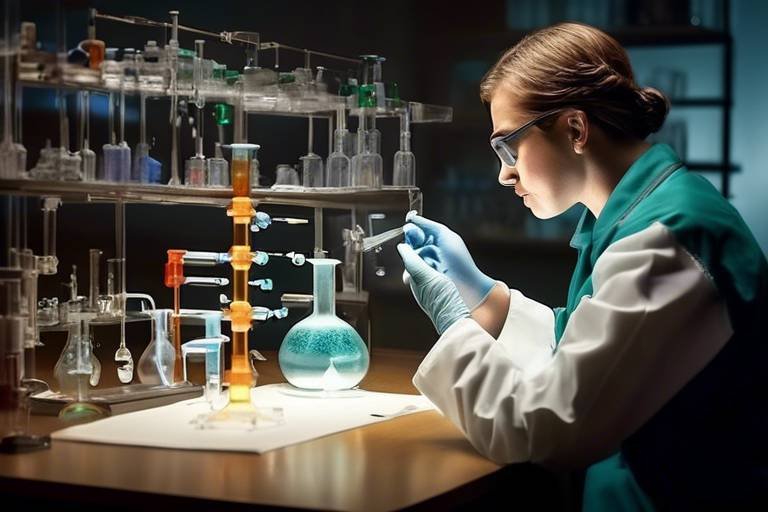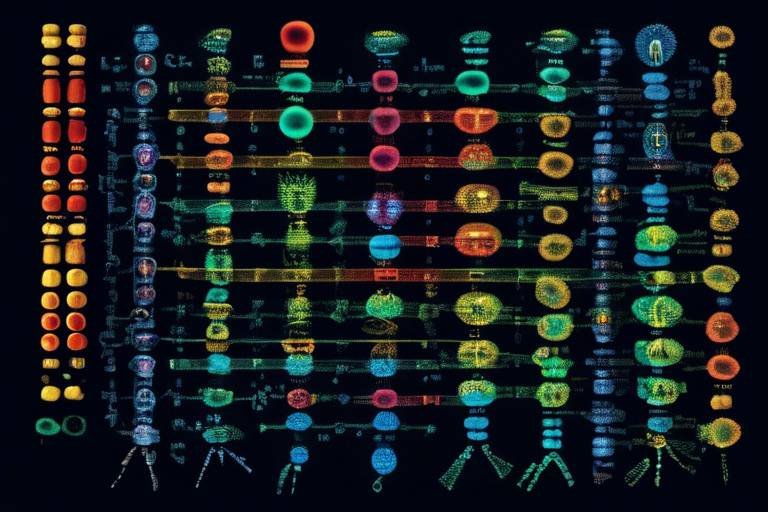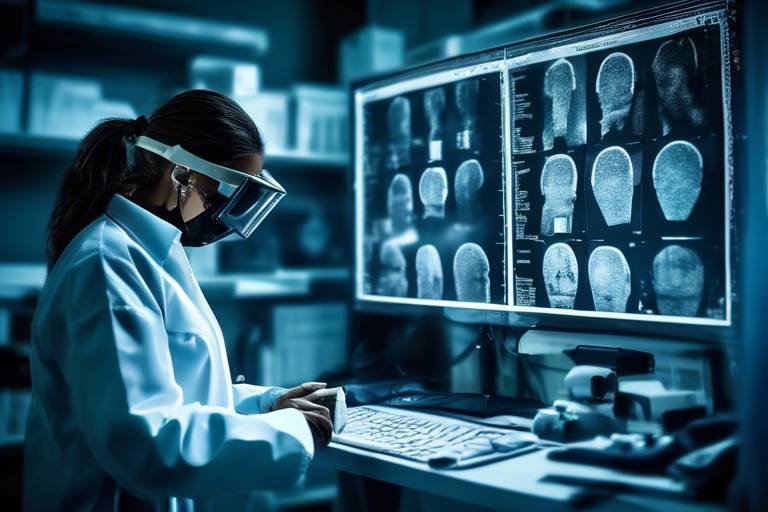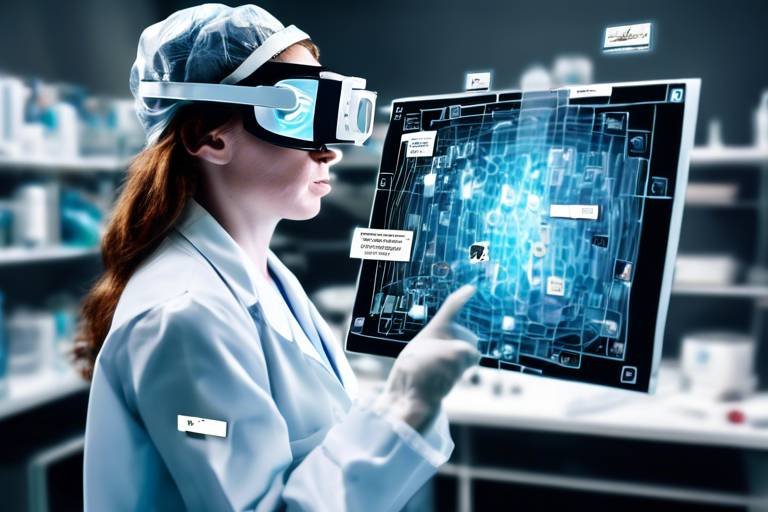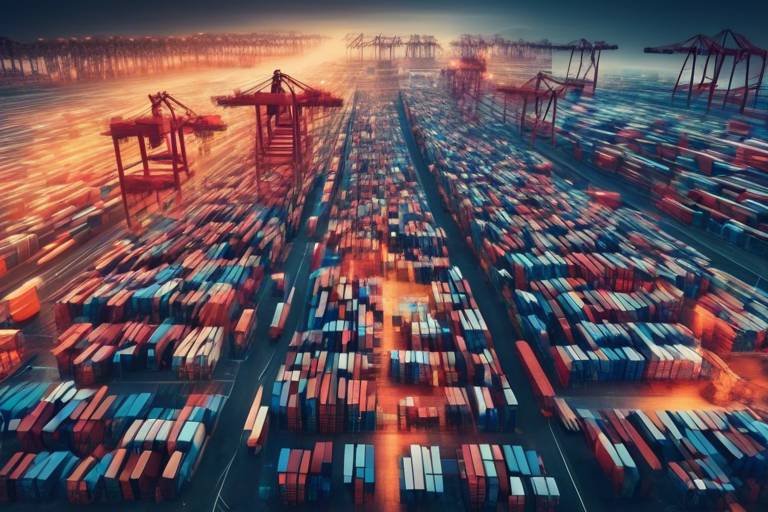How Technology is Reshaping the Field of Chemistry
In today's fast-paced world, technology is not just a tool; it's a game-changer, especially in the field of chemistry. From the way we conduct experiments to how we analyze data, technology is driving a seismic shift that is reshaping our understanding and application of chemical sciences. Imagine being able to predict the outcome of a chemical reaction before you even mix the substances! This is no longer a fantasy but a reality thanks to the advancements in computational chemistry and data analytics. The fusion of traditional chemistry with cutting-edge technology is paving the way for a future that is not only more efficient but also more sustainable.
As we delve deeper into this fascinating topic, we will explore various dimensions of how technology is enhancing research, analysis, and applications in chemistry. The innovations we discuss are not just theoretical; they are actively transforming laboratories and industries around the globe. Whether it's through automation, green chemistry initiatives, or the integration of artificial intelligence, the impact of technology on chemistry is profound and far-reaching.
Are you curious about how these advancements are making a difference? Let's take a closer look at some of the key areas where technology is playing a pivotal role in reshaping the landscape of chemistry.
Modern technology has revolutionized analytical techniques in chemistry, enabling more precise measurements and faster data acquisition. Techniques like mass spectrometry and chromatography are now more efficient and accessible than ever before. For instance, high-resolution mass spectrometry allows chemists to identify complex mixtures with unprecedented accuracy. This capability not only speeds up the research process but also enhances the reliability of results.
Furthermore, the integration of software tools for data analysis has transformed how chemists interpret their findings. With advanced algorithms and machine learning, chemists can now analyze data sets that were once considered too large or complex. This shift in analytical capability is akin to upgrading from a basic calculator to a powerful computer—it opens up a world of possibilities for research and discovery.
Computational chemistry is another area where technology shines. By leveraging powerful algorithms and supercomputers, scientists can model chemical systems and predict reactions and properties before conducting experiments. This not only saves time but also resources, as chemists can focus on the most promising avenues of research. Imagine being able to simulate a thousand experiments in a matter of hours—this is the power of computational chemistry.
The ability to predict outcomes also reduces the risk of failure in experimental setups, leading to more successful projects and innovations. The potential applications are vast, from drug discovery to materials science, and the implications for the future of chemistry are exciting.
Automation technologies, including robotics and artificial intelligence, are streamlining laboratory processes, reducing human error, and increasing throughput. This shift not only enhances productivity but also allows chemists to focus on complex problem-solving and creative thinking. For example, automated liquid handling systems can perform repetitive tasks with high precision, freeing up valuable time for researchers to engage in innovative projects.
Moreover, the integration of AI in data analysis is enabling chemists to uncover insights that were previously hidden. By automating routine tasks, laboratories can operate more efficiently, and researchers can dedicate their efforts to groundbreaking discoveries.
Technology plays a crucial role in promoting green chemistry by developing sustainable processes and materials. Innovations focus on reducing waste, energy consumption, and the use of hazardous substances. For instance, advancements in catalysis have led to more efficient chemical reactions that minimize byproducts and energy use. This commitment to sustainability is not just a trend; it's a necessity for the future of our planet.
As we face global challenges such as climate change and resource depletion, the role of technology in fostering sustainable practices in chemistry becomes increasingly important. By embracing green chemistry, we are not only improving our processes but also contributing to a healthier environment.
- How is technology improving chemical research? Technology enhances research by providing advanced analytical techniques, computational models, and automation, leading to faster and more accurate results.
- What role does AI play in chemistry? AI assists in data analysis, automates routine tasks, and helps predict chemical reactions, significantly increasing efficiency in research.
- Why is green chemistry important? Green chemistry focuses on sustainability, reducing waste and harmful substances, which is crucial for protecting the environment.

Advancements in Analytical Techniques
Modern technology has truly revolutionized analytical techniques in the field of chemistry, making it possible to achieve levels of precision and speed that were once thought impossible. Imagine being able to analyze a chemical sample in a fraction of the time it used to take, all while obtaining more accurate results. This is not just a dream; it's a reality thanks to innovations such as mass spectrometry and chromatography.
Mass spectrometry, for instance, has evolved from a cumbersome process requiring extensive manual input into a streamlined, automated technique that can handle complex mixtures with ease. This advancement allows chemists to identify compounds and determine their concentrations quickly, which is crucial in fields like pharmaceuticals and environmental science. With the integration of advanced software, researchers can now visualize the data more intuitively, enabling them to draw conclusions faster.
On the other hand, chromatography has seen significant enhancements as well. The introduction of high-performance liquid chromatography (HPLC) and gas chromatography (GC) has improved separation efficiency, allowing for the analysis of smaller sample sizes. This is especially beneficial in drug testing and forensic analysis, where every drop counts. Automation in these processes means that chemists can run multiple tests simultaneously, maximizing their productivity and minimizing the potential for human error.
To illustrate the impact of these advancements, consider the following table that highlights key differences in traditional and modern analytical techniques:
| Technique | Traditional Method | Modern Method |
|---|---|---|
| Mass Spectrometry | Manual sample preparation, longer analysis time | Automated processes, rapid analysis, high accuracy |
| Chromatography | Labor-intensive, larger sample sizes required | High efficiency, smaller sample sizes, automated runs |
The benefits of these advancements extend beyond mere efficiency. They also enhance the reliability of results, which is vital for regulatory compliance in industries such as food safety and pharmaceuticals. As these analytical techniques continue to evolve, chemists are finding new ways to push the boundaries of what is possible, leading to discoveries that can change our understanding of chemistry itself.
In conclusion, the advancements in analytical techniques are paving the way for a new era in chemistry. By embracing these innovations, chemists are not only improving their methodologies but also contributing to a more sustainable and efficient future for the field. So, the next time you think about chemistry, remember that it’s not just about test tubes and beakers; it’s about the exciting technological advancements that are shaping the future of science.
- What are the main benefits of modern analytical techniques? Modern analytical techniques offer increased precision, speed, and reliability, allowing for more efficient data analysis and decision-making.
- How has mass spectrometry changed in recent years? Mass spectrometry has become more automated, enabling quicker and more accurate analysis of complex mixtures.
- What role does automation play in chromatography? Automation in chromatography allows for simultaneous testing of multiple samples, reducing human error and increasing throughput.

Computational Chemistry Innovations
In the ever-evolving world of chemistry, computational chemistry stands out as a game-changer that has transformed how scientists approach chemical research. Imagine having the ability to predict the behavior of molecules before even mixing them in a lab. This is not just a dream; it's a reality made possible by powerful algorithms and supercomputers. These tools allow chemists to model complex chemical systems, providing insights that were once only attainable through trial and error.
One of the most significant breakthroughs in computational chemistry is the development of advanced simulation techniques. For instance, methods such as density functional theory (DFT) and molecular dynamics (MD) simulations enable researchers to visualize molecular interactions at an atomic level. This means that scientists can explore the potential outcomes of reactions, evaluate the stability of compounds, and even design new materials with desired properties—all before stepping foot into a laboratory.
Furthermore, the integration of machine learning into computational chemistry is opening up new frontiers. By analyzing vast datasets, machine learning algorithms can identify patterns and predict chemical behaviors with remarkable accuracy. This not only speeds up the research process but also reduces the need for extensive experimental validation. Imagine a world where a chemist can input parameters into a computer and receive a reliable prediction of a compound's reactivity in seconds. This shift is not just a convenience; it's a revolution that enhances innovation and efficiency in chemical research.
To illustrate the impact of computational chemistry, consider the following table that highlights some key innovations:
| Innovation | Description | Impact on Chemistry |
|---|---|---|
| Density Functional Theory (DFT) | A quantum mechanical method used to investigate the electronic structure of many-body systems. | Allows for accurate predictions of molecular properties and behaviors. |
| Molecular Dynamics (MD) | A simulation method that models the physical movements of atoms and molecules. | Helps in understanding the dynamics of molecular interactions over time. |
| Machine Learning Algorithms | Algorithms that learn from data to make predictions or decisions. | Enhances the speed and accuracy of chemical predictions, reducing experimental costs. |
The implications of these innovations extend far beyond the laboratory. They pave the way for breakthroughs in various fields, including materials science, pharmaceuticals, and environmental chemistry. For example, in drug development, computational chemistry can significantly shorten the time needed to discover new drugs by predicting how different compounds will interact with biological targets. This not only accelerates the process but also minimizes the use of resources and reduces waste.
As we look to the future, the role of computational chemistry will only grow. With advancements in technology and the increasing availability of computational power, the possibilities are limitless. The integration of artificial intelligence and big data analytics into computational chemistry will further enhance our ability to tackle complex chemical problems, leading to innovations that could change the world. The question is not whether computational chemistry will shape the future of science; rather, it's how profoundly it will do so.

Automation in Chemical Laboratories
Imagine walking into a chemical laboratory where robots are meticulously handling complex experiments, while human chemists oversee the process from a comfortable distance. This is not a scene from a futuristic movie; it’s the reality of modern chemical laboratories thanks to the rise of automation technologies. The integration of robotics and artificial intelligence (AI) has not only streamlined laboratory processes but has also significantly reduced human error, allowing for more accurate and reliable results. Automation is becoming the backbone of many laboratories, enhancing productivity and enabling chemists to focus on the more intricate aspects of their work.
One of the most profound impacts of automation is the increase in throughput. Automated systems can perform repetitive tasks at a speed and precision that far surpasses human capability. For instance, tasks such as sample preparation, mixing, and data collection can now be completed in a fraction of the time it would take a human. This efficiency is crucial in a field where time is often of the essence, especially when it comes to meeting tight deadlines for research projects or regulatory submissions.
Moreover, the ability to conduct high-throughput screening (HTS) has revolutionized drug discovery and materials science. With automated systems, researchers can test thousands of compounds in a short period, identifying potential candidates for further study without the tedious manual labor that once dominated the process. This not only accelerates discovery but also opens up new avenues for innovation, as chemists can explore a wider range of possibilities than ever before.
However, the transition to automation is not without its challenges. Laboratories must invest in training personnel to work alongside automated systems, ensuring that they understand both the technology and the chemistry involved. Additionally, there is a need for ongoing maintenance and updates to keep these systems running smoothly. But the benefits often outweigh the costs, as automation leads to a more efficient workflow and enhanced research capabilities.
Automation also fosters collaboration among scientists. With remote monitoring capabilities, chemists can oversee experiments from anywhere in the world. This opens up opportunities for international collaboration, allowing teams to work together seamlessly, share data in real-time, and contribute to research projects without the constraints of geographical boundaries.
In conclusion, the integration of automation in chemical laboratories is a game-changer. By reducing human error, increasing throughput, and enhancing collaboration, automation is paving the way for a new era of chemical research. As technology continues to evolve, we can expect even greater advancements that will further transform the landscape of chemistry.
- What are the main benefits of automation in chemical laboratories?
Automation increases efficiency, reduces human error, and allows chemists to focus on complex problem-solving. - How does automation impact drug discovery?
Automated systems enable high-throughput screening, allowing researchers to test thousands of compounds quickly. - What challenges do laboratories face when implementing automation?
Challenges include the need for personnel training, system maintenance, and the initial investment costs. - Can automation enhance collaboration among scientists?
Yes, automation allows for remote monitoring and real-time data sharing, facilitating international collaboration.

Green Chemistry and Sustainable Practices
In today's world, where environmental concerns are more pressing than ever, green chemistry has emerged as a beacon of hope in the quest for sustainability. It’s not just about making chemistry less harmful; it’s about reimagining the very processes we use to create and analyze chemical compounds. The advent of technology has played a pivotal role in this transformation, allowing chemists to develop innovative methods that minimize waste and reduce the use of hazardous materials.
One of the key principles of green chemistry is the design of chemical processes that reduce or eliminate the generation of hazardous substances. This involves using renewable resources and developing safer chemicals that can break down naturally in the environment. For instance, advancements in biocatalysis have enabled the use of enzymes in chemical reactions, which often require milder conditions and produce fewer by-products compared to traditional methods.
Furthermore, technology has facilitated the development of alternative solvents that are less toxic and more environmentally friendly. Traditional organic solvents are notorious for their harmful effects on both human health and the environment. By employing ionic liquids or supercritical fluids, chemists can perform reactions with reduced environmental impact. The table below highlights some common solvents and their environmental impacts:
| Solvent Type | Environmental Impact | Green Alternative |
|---|---|---|
| Acetone | Volatile organic compound (VOC) | Ionic Liquids |
| Benzene | Carcinogenic | Supercritical CO2 |
| Chloroform | Harmful to aquatic life | Water |
Another significant advancement is the use of computer modeling to predict the environmental impact of chemical processes before they are executed. By simulating reactions, chemists can identify potentially harmful outcomes and modify their approaches accordingly. This predictive capability is invaluable, as it allows for the optimization of processes in a virtual space, leading to safer and more sustainable practices.
Moreover, the shift towards sustainable practices in chemistry is not just about the chemicals themselves but also about the energy used in chemical processes. Innovations such as microwave-assisted synthesis and solar-powered reactions are gaining traction. These methods not only enhance reaction rates but also significantly lower energy consumption, aligning with the principles of green chemistry.
As we look to the future, it’s clear that the integration of technology in green chemistry is not just a trend; it’s a necessity. With the ongoing challenges of climate change and resource depletion, chemists must continue to innovate and adopt sustainable practices. The collaboration between chemists, environmental scientists, and technologists will be crucial in developing solutions that are not only effective but also safe for our planet.
In summary, green chemistry and sustainable practices represent a critical shift in the field of chemistry, driven by technological advancements. This evolution is paving the way for a more sustainable future, where chemistry can contribute positively to the environment rather than detract from it. As we embrace these changes, the potential for creating a greener world becomes more achievable than ever.
- What is green chemistry? Green chemistry refers to the design of chemical products and processes that reduce or eliminate the use and generation of hazardous substances.
- How does technology contribute to green chemistry? Technology enables the development of safer chemicals, alternative solvents, and more efficient processes that minimize environmental impact.
- What are some examples of green chemistry practices? Examples include using biocatalysts, alternative solvents, and energy-efficient methods like microwave-assisted synthesis.
- Why is sustainable chemistry important? Sustainable chemistry is essential for reducing pollution, conserving resources, and ensuring a healthier environment for future generations.

Data Science and Chemistry
In today's fast-paced world, the intersection of data science and chemistry is nothing short of revolutionary. Imagine a chemist working in a lab, surrounded by complex equations and intricate experiments. Now, picture them armed with powerful data analytics tools that can sift through mountains of data in seconds. This is the new reality for chemists, where data science is not just an accessory but a core component of modern chemical research.
The integration of data science into chemistry has opened up a treasure trove of possibilities. By utilizing advanced statistical methods and machine learning algorithms, chemists can analyze vast datasets to uncover hidden patterns and correlations that were previously unimaginable. For instance, researchers can now predict the outcomes of chemical reactions with remarkable accuracy, allowing them to focus their efforts on the most promising avenues of exploration. This predictive capability not only saves time but also significantly reduces the amount of resources spent on trial-and-error experiments.
One of the key advantages of data science in chemistry is its ability to handle big data. As experiments generate more data than ever before, traditional methods of analysis become cumbersome and inefficient. Here’s where data science shines. By employing techniques such as data mining and predictive modeling, chemists can extract meaningful insights from complex datasets. This approach not only enhances the understanding of chemical processes but also enables the discovery of new compounds and materials.
Moreover, the collaboration between chemists and data scientists is fostering a culture of innovation. Chemists are increasingly recognizing the value of data science skills, leading to interdisciplinary teams that combine domain expertise with analytical prowess. This collaboration is particularly evident in areas such as drug discovery, where the ability to analyze large datasets can lead to breakthroughs in understanding disease mechanisms and developing targeted therapies.
To illustrate the impact of data science on chemistry, consider the following table that highlights some of the key applications:
| Application | Description | Benefits |
|---|---|---|
| Predictive Modeling | Using algorithms to forecast chemical behaviors and reactions. | Increased efficiency in experimental design. |
| Data Mining | Extracting useful information from large datasets. | Uncovering hidden patterns and insights. |
| Machine Learning | Training models to improve over time based on data. | Enhanced accuracy in predictions and analyses. |
| Visualization Tools | Graphical representations of complex data. | Improved understanding and communication of results. |
As we look to the future, the role of data science in chemistry is only set to grow. With advancements in artificial intelligence and machine learning, we can expect even more sophisticated analytical tools that will further enhance our ability to understand and manipulate chemical systems. The potential for innovation is enormous, and the possibilities are as exciting as they are limitless.
In conclusion, the fusion of data science and chemistry is reshaping the landscape of scientific research. By embracing data-driven approaches, chemists are not only enhancing their research capabilities but are also paving the way for groundbreaking discoveries that can address some of the most pressing challenges in science and industry today.
- What is data science in chemistry? Data science in chemistry involves the application of statistical methods, algorithms, and computational techniques to analyze chemical data and predict outcomes.
- How does data science improve chemical research? By enabling chemists to analyze large datasets quickly and accurately, data science helps in uncovering patterns, optimizing experiments, and facilitating discoveries.
- What tools are commonly used in data science for chemistry? Common tools include Python, R, and various machine learning frameworks that assist in data analysis and visualization.
- Can data science help in drug discovery? Yes, data science plays a crucial role in drug discovery by analyzing biological data to identify potential drug candidates and predict their effectiveness.

Emerging Technologies in Drug Development
The landscape of drug development is undergoing a remarkable transformation, driven by emerging technologies that are redefining how we discover, develop, and deliver medications. Gone are the days of lengthy and often uncertain drug development timelines; today, we are witnessing a surge in innovations that not only expedite the process but also enhance the precision and effectiveness of new therapies. For instance, the integration of machine learning and artificial intelligence into the drug discovery process allows researchers to analyze vast amounts of biological data, identifying potential drug candidates more efficiently than ever before.
One of the most exciting advancements is the use of high-throughput screening (HTS), which enables scientists to rapidly test thousands of compounds for their efficacy against specific biological targets. This technology drastically reduces the time it takes to identify promising candidates for further development. In fact, HTS can screen millions of compounds in a matter of days, which was previously unimaginable. Coupled with computational modeling, these technologies allow researchers to predict how different compounds will behave in the human body, thereby minimizing the need for extensive animal testing.
Another groundbreaking innovation is the rise of personalized medicine. With advancements in genomics and biotechnology, scientists can now tailor treatments to individual patients based on their genetic makeup. This approach not only improves the likelihood of successful outcomes but also reduces the risks of adverse reactions. By analyzing a patient's genetic profile, healthcare providers can select the most effective therapies, making drug development more patient-centric than ever.
Moreover, the advent of biologics and monoclonal antibodies has opened new avenues for treating complex diseases such as cancer and autoimmune disorders. These biologic drugs are derived from living organisms and can be engineered to target specific pathways in the body, providing more effective and less toxic treatment options. The development of these therapies is often accelerated by cutting-edge technologies such as CRISPR gene editing, which allows for precise modifications at the genetic level, paving the way for innovative treatments.
Furthermore, the efficiency of clinical trials is being dramatically enhanced through the use of digital health technologies. Wearable devices and mobile health applications are being utilized to monitor patients in real-time, providing invaluable data that can inform trial outcomes. This not only improves patient engagement but also allows for more agile trial designs that can adapt to emerging data. Consequently, the time it takes to bring new drugs to market is significantly reduced.
In summary, the convergence of these emerging technologies is revolutionizing drug development, making it faster, more efficient, and increasingly tailored to individual patient needs. The future of pharmacology looks promising, with innovations that not only enhance the development process but also improve the overall quality and accessibility of healthcare.
- What are some key technologies transforming drug development?
Technologies like machine learning, high-throughput screening, and CRISPR gene editing are significantly changing the landscape of drug development. - How does personalized medicine impact drug development?
Personalized medicine allows for treatments tailored to individual genetic profiles, improving treatment efficacy and reducing adverse effects. - What role do digital health technologies play in clinical trials?
Digital health technologies enhance patient monitoring and engagement, providing real-time data that can improve trial outcomes and efficiency.

Nanotechnology in Chemistry
Nanotechnology is not just a buzzword; it's a groundbreaking field that is fundamentally changing the landscape of chemistry. Imagine being able to manipulate materials at the atomic level—this is precisely what nanotechnology allows chemists to do. By working with materials that are just a few nanometers in size, scientists can create substances with unique properties that are often not found in their bulk counterparts. For instance, materials can become stronger, lighter, or even more reactive when reduced to the nanoscale. This opens up a world of possibilities for innovation across various industries.
One of the most exciting applications of nanotechnology in chemistry is in the development of nanomaterials. These materials can be engineered for specific functions, leading to advancements in fields such as electronics, medicine, and environmental science. For example, in drug delivery systems, nanoparticles can be designed to target specific cells, ensuring that medications are delivered precisely where they are needed, thus minimizing side effects and improving efficacy.
Additionally, nanotechnology enhances the performance of catalysts, which are substances that speed up chemical reactions. By increasing the surface area of a catalyst at the nanoscale, chemists can improve its efficiency significantly. This is particularly important in green chemistry, where the goal is to create processes that are not only effective but also environmentally friendly. As a result, nanocatalysts can lead to more sustainable chemical processes by reducing energy consumption and waste generation.
Moreover, the integration of nanotechnology in materials science has paved the way for the creation of smart materials. These are materials that can respond to external stimuli, such as temperature or light. For instance, photoresponsive nanomaterials can change their properties when exposed to light, making them ideal for applications in sensors and actuators. This adaptability is a game-changer, allowing for the development of innovative products that can adjust their behavior based on the environment.
In summary, the impact of nanotechnology on chemistry is profound and multifaceted. It not only enhances the capabilities of traditional materials but also introduces entirely new avenues for research and application. As we continue to explore and understand the nanoscale world, the potential for transformative discoveries is limitless. The future of chemistry is undoubtedly intertwined with the advancements in nanotechnology, promising to tackle some of the most pressing challenges we face today.
- What is nanotechnology? Nanotechnology is the manipulation of matter on an atomic or molecular scale, typically below 100 nanometers.
- How is nanotechnology used in medicine? It is used for targeted drug delivery, imaging, and developing new therapies.
- What are nanomaterials? Nanomaterials are materials that have unique properties due to their nanoscale size, making them suitable for various applications.
- What is a nanocatalyst? A nanocatalyst is a catalyst that has been engineered at the nanoscale to increase its efficiency in speeding up chemical reactions.
- Are there any risks associated with nanotechnology? Yes, there are potential risks, including environmental and health concerns, which are currently being studied.

Collaboration and Open Science
In today's fast-paced world, the concept of collaboration and open science has become more than just a trend; it's a necessity. With the vast amount of data generated in the field of chemistry, sharing knowledge and resources can significantly accelerate the pace of scientific discovery. Imagine a global network of chemists, each contributing their unique insights and findings, working together as a cohesive unit. This collaborative spirit is fostered by technological advancements that allow researchers to connect, share, and innovate like never before.
One of the most exciting aspects of this movement is the development of online platforms that facilitate the sharing of research data and methodologies. These platforms not only allow scientists to publish their findings openly but also enable real-time collaboration across geographical boundaries. For instance, researchers from different parts of the world can work on a single project, analyzing data and discussing results through virtual meetings and shared databases. This approach not only enhances the quality of research but also promotes transparency, as findings are accessible to anyone interested.
Moreover, open science initiatives encourage the use of open-source software and tools, which democratize access to advanced analytical techniques. By providing free access to software and databases, researchers—regardless of their institutional affiliations—can utilize cutting-edge technologies to advance their work. This is particularly beneficial for those in developing countries, where resources may be limited. The result? A more inclusive scientific community that fosters innovation and creativity.
However, collaboration is not without its challenges. Issues such as data privacy, intellectual property rights, and the need for standardized protocols can sometimes hinder the seamless flow of information. To address these concerns, many organizations are working towards creating frameworks that balance the need for openness with the protection of individual contributions. By establishing clear guidelines and agreements, the scientific community can navigate these complexities while still reaping the benefits of collaboration.
As we look towards the future, it's clear that the integration of collaboration and open science into the field of chemistry will continue to evolve. With emerging technologies like blockchain, which offers secure data sharing, and artificial intelligence, which can analyze patterns in vast datasets, the potential for groundbreaking discoveries is limitless. By embracing this collaborative ethos, chemists can tackle some of the world's most pressing challenges, from climate change to public health crises.
In summary, the synergy created by collaboration and open science is transforming the landscape of chemistry. It empowers researchers to share knowledge, enhances the quality of scientific inquiry, and ultimately leads to innovations that can benefit society as a whole. The future of chemistry is not just about individual achievements but about collective progress—one that is driven by the spirit of collaboration and the pursuit of knowledge for all.
- What is open science? Open science refers to the practice of making scientific research, data, and methodologies accessible to all, promoting transparency and collaboration.
- How does collaboration enhance research? Collaboration allows researchers to pool their expertise and resources, leading to more comprehensive studies and faster discoveries.
- What challenges does open science face? Challenges include data privacy concerns, intellectual property rights, and the need for standardized protocols to facilitate sharing.
- How can technology support collaboration in chemistry? Technology provides platforms for data sharing, virtual communication tools, and open-source software that democratize access to research tools.

Future Trends in Chemical Technology
The future of chemical technology is not just a continuation of the past; it's a thrilling leap into uncharted territories that promise to redefine the landscape of science and industry. With the rapid pace of innovation, we can expect to see an array of groundbreaking trends that will shape the field in the coming years. One of the most exciting areas is the integration of artificial intelligence (AI) into chemical research. Imagine algorithms that can predict molecular behavior with astonishing accuracy—this is not science fiction; it’s happening now! AI will enable chemists to make faster, more informed decisions, ultimately accelerating the pace of discovery.
Another trend is the rise of biotechnology, which is merging biology with chemistry to create novel solutions for health and environmental challenges. For instance, bioengineered enzymes are being developed to catalyze reactions more efficiently than traditional methods, significantly reducing energy consumption and waste. This shift towards biology-driven chemistry not only enhances productivity but also aligns with the principles of green chemistry, which focuses on sustainability.
Moreover, the development of advanced materials is set to revolutionize various industries, from electronics to healthcare. Nanotechnology plays a pivotal role here, allowing scientists to manipulate materials at the atomic scale. This capability opens doors to creating materials with customized properties, such as enhanced strength, lighter weight, and improved conductivity. As we continue to explore the nanoscale, the potential for innovation seems limitless.
Let's not forget about the increasing importance of data analytics in chemical research. The ability to process and analyze vast amounts of data is transforming how chemists conduct experiments and interpret results. With the advent of machine learning, researchers can now uncover hidden patterns in chemical data, leading to new insights and faster development cycles. This synergy between chemistry and data science is a game-changer, enabling more precise predictions and efficient workflows.
As we look to the future, it’s clear that collaboration will be key. The rise of open science platforms is fostering a culture of transparency and sharing among researchers worldwide. This collaborative spirit not only accelerates progress but also democratizes access to knowledge, allowing scientists from diverse backgrounds to contribute to the field. By breaking down silos, we can harness collective intelligence to tackle some of the most pressing challenges facing humanity, such as climate change, health crises, and resource scarcity.
In summary, the future of chemical technology is poised for remarkable advancements driven by AI, biotechnology, advanced materials, data analytics, and collaborative research. As these trends converge, they will not only enhance our understanding of chemical processes but also lead to practical applications that improve our quality of life. The question is, are we ready to embrace the changes that lie ahead?
- What role does artificial intelligence play in chemical technology? AI helps predict molecular behavior and optimize research processes, leading to faster discoveries.
- How is biotechnology influencing chemistry? Biotechnology combines biology and chemistry to create sustainable solutions, such as bioengineered enzymes.
- What are advanced materials? These are materials designed at the molecular level for specific properties, often enhanced by nanotechnology.
- Why is data analytics important in chemistry? It allows for the analysis of large datasets to uncover new insights and improve experimental efficiency.
- What is open science? Open science is a collaborative approach that promotes transparency and sharing of research, accelerating scientific progress.
Frequently Asked Questions
-
How has technology improved analytical techniques in chemistry?
Modern technology has significantly enhanced analytical techniques, making them more precise and faster. Innovations like mass spectrometry and chromatography now allow chemists to obtain results quickly and accurately, which means they can focus on more complex analyses without the tedious wait times.
-
What role does computational chemistry play in research?
Computational chemistry uses advanced algorithms and supercomputers to simulate chemical reactions and properties. This means scientists can predict the outcomes of experiments before they even start, saving valuable time and resources. It's like having a crystal ball for chemical reactions!
-
How is automation changing chemical laboratories?
Automation, including robotics and AI, is streamlining lab processes. By reducing human error and increasing throughput, chemists can spend less time on repetitive tasks and more time on innovative problem-solving. Imagine a lab where robots handle the mundane, allowing scientists to unleash their creativity!
-
What is green chemistry, and how does technology support it?
Green chemistry focuses on designing chemical processes that are environmentally friendly. Technology aids this by developing sustainable materials and processes that minimize waste and energy use. It's all about making chemistry safer and more sustainable for our planet.
-
How does data science impact chemistry?
The integration of data science into chemistry allows researchers to analyze vast datasets, uncovering patterns and insights that drive innovation. Machine learning, for instance, helps optimize chemical processes, making them more efficient. It's like having a super-smart assistant that helps chemists make data-driven decisions.
-
What advancements are being made in drug development through technology?
Technological advancements are revolutionizing drug development with better screening methods, personalized medicine, and quicker clinical trials. These innovations help bring new drugs to market faster, making treatments more effective and accessible to patients.
-
How is nanotechnology influencing chemistry?
Nanotechnology is a game changer in materials science and chemistry. By allowing scientists to design materials at the molecular level, it enhances properties and creates new applications across various industries. Think of it as crafting materials with superpowers!
-
What is the significance of collaboration in chemical research?
Technology promotes collaboration among chemists worldwide through platforms for data and research sharing. Open science initiatives foster transparency and accelerate discoveries, making it easier for scientists to work together and tackle global challenges.
-
What future trends should we expect in chemical technology?
Looking ahead, trends like artificial intelligence, biotechnology, and advanced materials will continue to reshape chemistry. These innovations will drive research forward and help address pressing global issues, paving the way for a more sustainable future.

